In early April 1982, Argentina invaded the Falkland Islands, a few desolate rocks in the South Atlantic. The British mobilized their fleet in response. The carriers arrived off the Falklands on May 1st, swiftly defeating the Argentine Air Force. The Argentine Navy tried to interfere the next day, but withdrew after the cruiser General Belgrano was sunk by a submarine. Two days later, the Argentinians struck back, sinking the frigate Sheffield with an Exocet missile. Two weeks later, on May 21st, British troops landed at San Carlos Water on the west coast of East Falkland. The Argentine Air Force quickly got wind of this, and launched numerous sorties against the invasion fleet. The brutal battle ran for five days before the Argentinian attacks petered out. Unfortunately, the 25th saw the destroyer Coventry and the cargo ship Atlantic Conveyor sunk by air attack. Atlantic Conveyor's loss was particularly damaging, as she carried helicopters intended to move the land forces forward. Instead, they would have to walk.1

Queen Elizabeth 2 sails for the South Atlantic
But it was finally time for the British to take the offensive on land. Stanley was clearly the center of gravity of the Argentinian occupation force, and capturing it would probably end the war. The five battalions2 currently in the Falklands weren't enough to be sure of this, so a second brigade, 5 Infantry Brigade, had been assembled. Normally, 5 Infantry Brigade was largely an airborne formation, built around 2 Para, 3 Para and a battalion of Gurkhas. However, 2 Para and 3 Para had been attached to 3 Commando Brigade, so replacements had to be sourced in a hurry. Two battalions of The Guards, previously tasked with ceremonial duties in London were tapped, and hastily trained for the mountainous, sub-arctic conditions of the Falklands. On May 12th, these battalions, along with the Gurkhas, 5 Infantry Brigade's support units, and various other forces, set sail aboard the Queen Elizabeth 2.
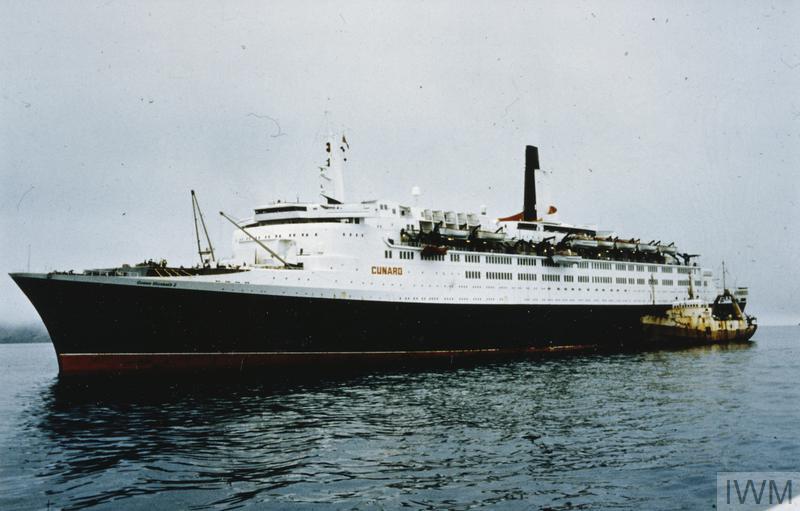
Queen Elizabeth 2 transships troops at South Georgia
Bringing the massive liner near the Falklands with thousands of troops onboard was seen as too dangerous, and she was instead dispatched to South Georgia, arriving on May 27th. There, she was met by Canberra and Norland, fresh from San Carlos. Over the next 24 hours, 3000 men and 250 tons of supplies were transferred by trawler, small boat and helicopter despite the South Georgia weather. The urgency was partially due to the need to get troops to the Falklands, and partially due to the threat of air attack, as the heaviest AA weapon in the area was a 40mm gun and the BBC had helpfully announced that QE2 was approaching the combat area. The next day was spent unloading more supplies from QE2, but when she sailed on the 29th, a great deal of 5 Brigade's artillery and mortar ammunition was still onboard.3
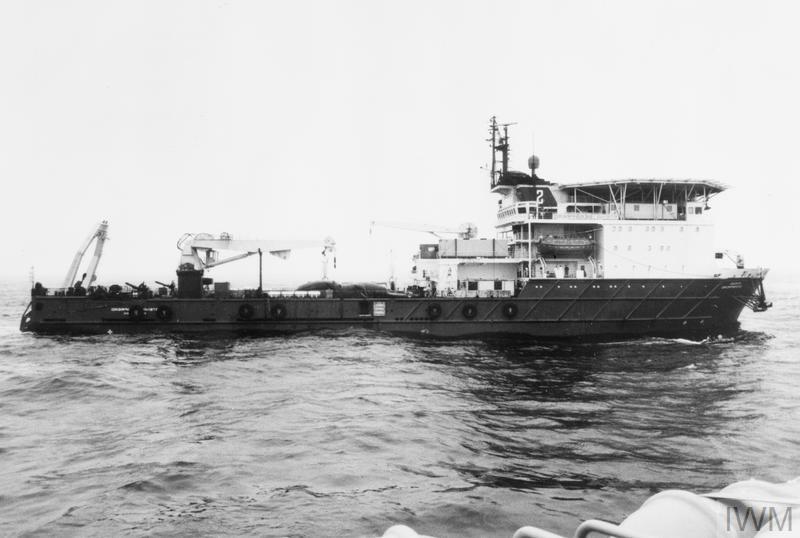
Repair ship Stena Seaspread
The 26th was fairly quiet on the Falklands themselves. The Argentinians had developed a new tactic, sending out "spoof raids" composed of Mirages or Learjets, which would turn back when the air controllers of VYCA-2 saw the Harriers moving to intercept. The British jets, short on fuel, couldn't pursue far enough to actually engage, and each chase meant a pair had to go home and refuel. Fortunately, the Argentinian strike aircraft were also at the limits of their range, so when VYCA-2 diverted a real raid to protect it from interception, it didn't have enough gas to make a second attack. The only "successful" raid of the day was made by Skyhawks whose bombs fell harmlessly near 2 Para's positions on the south end of the beachhead.
Outside of Stanley itself, the only major Argentinian concentration on East Falkland was around Darwin and Goose Green, 12 miles south of the beachhead. The force there had only limited offensive capability, so the initial plan had been to bypass it. However, it would be at least a week before enough forces were in position to begin the attack on Stanley, and the British felt the need for a victory before then, so 2 Para moved out at dusk on the 26th, with the attack scheduled for the next evening. They made it into position undetected, but the BBC soon announced that the British were about to attack Goose Green, sparking predictable fury among the men in the Falklands.
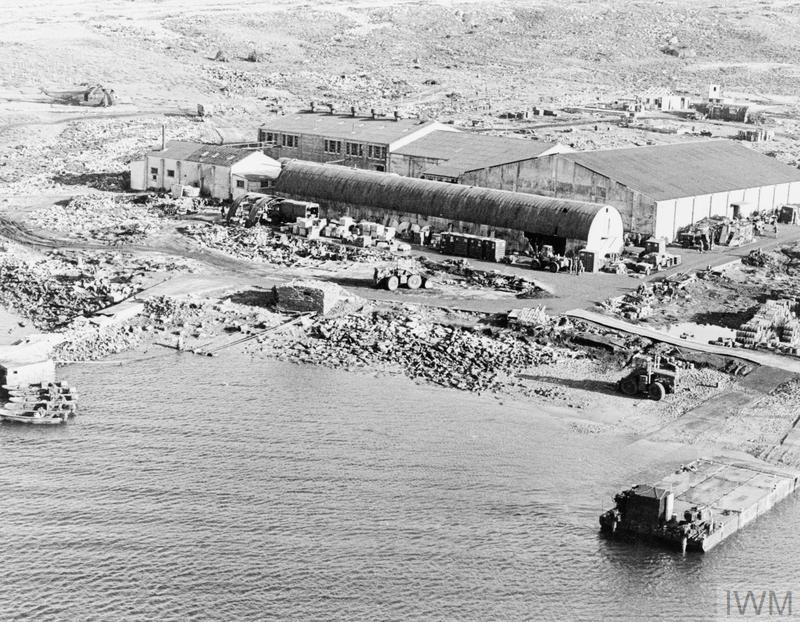
The brigade hospital at Ajax Bay
The 27th saw both sides make air attacks on the opposing positions. British Harrier GR.3s bombed Goose Green with little success, but when they came around to strafe the Argentine positions, one was shot down by AA fire. The pilot ejected safely, and was picked up three days later. Other Harriers lofted bombs at Stanley, delay-fuzed to go off during the night and disrupt the supply flights. Two pairs of Skyhawks attacked San Carlos. One strike, lead by Primer Teniente Velasco, who had previously led the strikes on Argonaut and Coventry, managed to bomb the old refrigeration plant at Ajax Bay, now serving as the field hospital for the brigade, as well as the ordnance dump nearby. Fortunately, the bomb that hit the hospital failed to go off, although it alarmed the staff and patients there. The ordnance dump wasn't so lucky, and the resulting explosions killed 5 men and wounded 20 more. Velasco's Skyhawk was hit by Fearless's 40mm gun, and he ejected safely over West Falkland. The other pair of Skyhawks bombed some of 40 Commando's positions, killing two men but doing minimal material damage.
Several other raids were launched, but failed to find San Carlos despite the fire in the Brigade Maintenance Area. They were the last attempted low-level attacks on the main beachhead. The battle would move elsewhere as the British began to spread across East Falkland. 45 Commando and 3 Para set off for Teal Inlet on the north side of the island, where a forward logistics base would be established for the attack on Stanley. 40 Commando remained behind to guard San Carlos, while 42 Commando was tapped as the 3 Commando Brigade reserve, ready to seize any opportunity that might present itself.
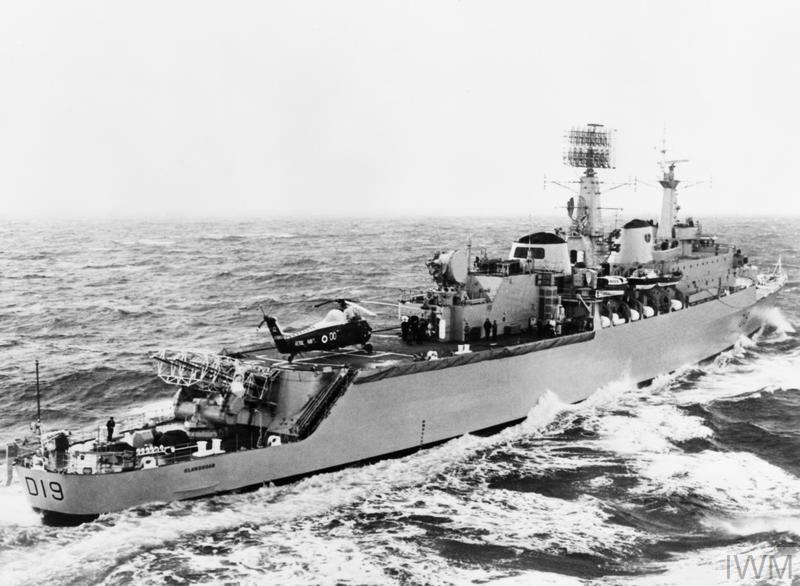
Glamorgan showing off her Sea Slug launcher
To cover the forthcoming attack on Goose Green, the British laid on a heavy bombardment in the closing hours of the 27th. Three ships, Alacrity, Avenger and Glamorgan, were detached from the carriers to hit targets around Stanley. To her 4.5” gun, Glamorgan added one of her Sea Slug missiles, obsolete against aircraft but significantly more powerful than any shell they could muster. The Argentinians replied with a missile of their own. Exocets had been stripped from a corvette and flown into Stanley, where they were mounted on a trailer and targeted by the radars already on the island. One was fired at Avenger, but it missed, flying about 5’ above the ship’s deck. Elsewhere, Yarmouth bombarded Port Howard on West Falkland, while Arrow moved into position to provide fire support and star shells for the attack on Goose Green.
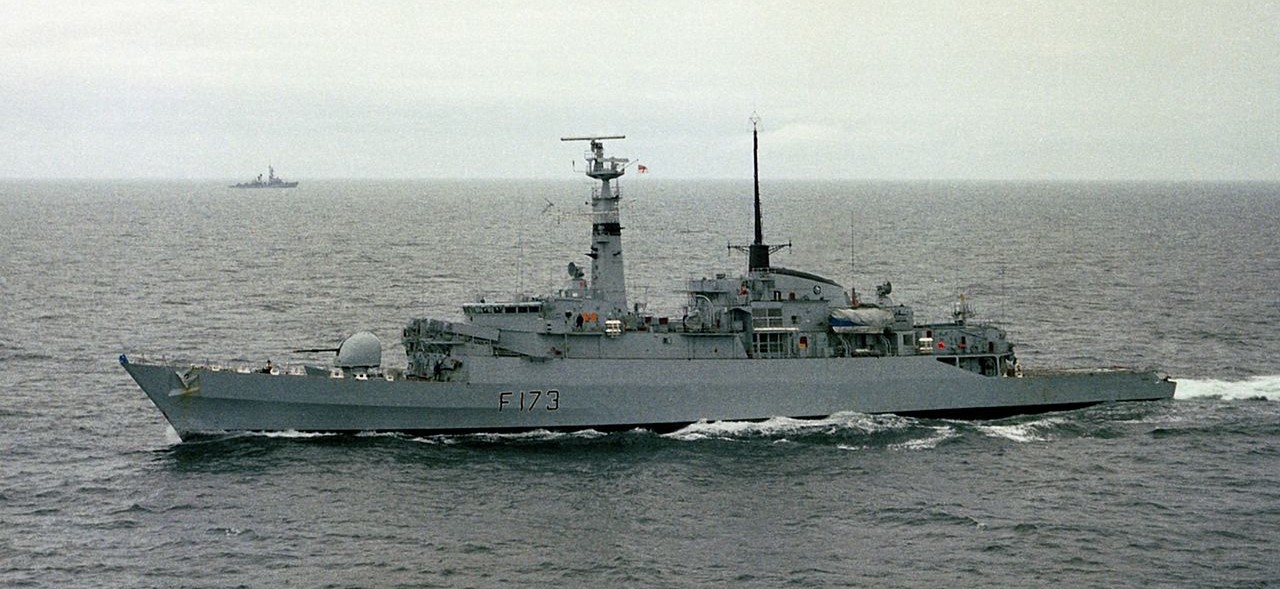
Arrow
The attack kicked off at around 0330 that morning, and Arrow provided valuable fire support during the opening hours of the battle. However, as she withdrew just before dawn, to avoid sharing Ardent's fate, the Paras began to run into serious resistance from the Argentine defenders. In the early morning, 2 Para's commander, Lieutenant-Colonel H. Jones, was mortally wounded during a one-man charge intended to get the Paras moving again. A helicopter sent in to evacuate him was shot down by a Pucara, but he was awarded a posthumous Victoria Cross4 for his bravery. The Paras slowly worked their way south down the isthmus, taking Darwin Hill around 1300, where they were stalled by fire from Argentinian AA guns. Bad weather kept both sides from making much use of air support. Pucaras from Goose Green itself attempted to use napalm, but the inaccuracy of their tanks meant they were no more than a minor nuisance, and British Blowpipes claimed two of the aircraft, along with a Macchi later in the afternoon. Finally, around 1530, a trio of Harrier GR.3s were called in and managed to silence the AA guns, clearing the way for the Paras to take the airfield. Night fell with both sides in a precarious position, and despite Argentine attempts to reinforce,5 the British managed to helicopter in more men and guns,6 and the defenders surrendered early on the 29th. The British had lost 18 killed and 64 wounded, while the Argentinians lost around 50 killed and 130 wounded, with 961 captured.

The Battle of Goose Green
The first major land battle in the Falklands had been a British victory, and it was the beginning of the end for the defenders. The Paras had managed to take an entrenched position against a force roughly equal to their own, and with relatively light casualties. On the 29th, 45 Commando and 3 Para took Teal Inlet, while the British were quick to seize an opportunity presented when a company that had previously been guarding Mount Kent, one of the peaks overlooking Stanley, was helicoptered to reinforce Goose Green. SAS patrols quickly occupied the summit, and held it against attempts to retake it until 42 Commando could be lifted in on the 30th. Artillery swiftly followed, the first shells falling on Stanley on June 1st. The way was open for the final assault to begin. We'll pick up that story next time.
1 For more information on ships and aircraft, as well as links to the whole series, see my Falklands Glossary. ⇑
2 40, 42, and 45 Commando of the Royal Marines, plus 2 and 3 Para from the Parachute Regiment. ⇑
3 An amusing sidenote was also going on at South Georgia at this time. The Argentinian "scrap metal merchants" who had invaded the island had actually brought a lot of metalworking supplies with them, which were requisitioned by the British and used to equip the oilfield support vessel-turned-repair ship Stena Seaspread. ⇑
4 The British equivalent of the American Medal of Honor. ⇑
5 An amusing incident took place during the night of the 28th. The Argentine Air Force dispatched its first night raid, but the Canberras missed San Carlos by 10 miles and bombed an area the British hadn't even occupied. ⇑
6 One of the reinforcing units was J Company 42 Commando, composed of the men of the Falklands Marine Detachment who had been captured at the start of the war. ⇑

Comments
Off-topic I know but I don't have time to wait until the next open thread:
What is the plural for Tirpitz?
This is required for my work. Seriously.
I've had people use Tirpii, which is both ridiculous and it isn't even a Latin word (I assume?), so I need the answer.
Who was telling the Beeb what was going on? Highly irresponsible, especially since the information has such a short shelf-life.
-e and -en are both plausible plurals for Tirpitz. But German is a cruel and arbitary mistress, so I've no idea which is correct.
@doctorpat
I'd assume Tirpitzes. It's originally a proper name, so there aren't any pseudo-Lantinate suffixes to get worked up over.
@Lambert
That's a very good question, and one that I've never seen addressed. Based on the very limited communication links from the South Atlantic, I think it had to be someone in the UK who had access to the information and was leaking it to the Beeb for some reason. I'm not sure why there wasn't a through investigation and punishment of the leaker. Anyone who knows more about British politics of the day is free to speculate.
Did Fearless shoot down a Skyhawk with what is essentially a WWII era Bofors? Since it wasn't bombing Fearless the gunners would likely have had to lead Velasco by a significant angle. I'm pretty impressed by that, given the size and speed of the target.
I think it may have been the L/70 Bofors instead of the L/60, and I have no idea offhand what sort of fire control it was hooked up to. But essentially, yes, they did. On one hand, that is kind of impressive, but on the other, there was a lot of metal in the air over San Carlos, and eventually some of it would end up sharing airspace with something vital on a Skyhawk.
I've heard some criticism of Jones for leading an attack as a Colonel, and that the VC he got was as much for PR as because he deserved it - a private in the same position might have, but he wasn't doing his actual job when he let himself get shot.
Any thoughts?
Following from the Fearless comment, I've just seen that the Royal Navy are fitting the type 31 with 40mm Bofors but no more rapid firing CIWS, so either they are pretty relaxed about anti-ship missiles, or they put a lot of trust in a gun that old. If the US fits even coastguard cutters with Phalanx it seems like a major omission on vessels that might be sent into harm's way.
Or they're doing "fitted for but not with", which has been pretty common RN practice for the last few decades. The 40 is probably for shooting at small boats and maybe drones.
That's pretty plausible. Looking at the pictures, I'd guess they'd have to remove the Bofors to make space for them. The whole concept behind "for but not with" assumes a clear build up of tension before conflict, so I wouldn't be surprised if they have to make do with what they are built with. I suppose the Dukes managed without.
Those 40mm guns aren't something along the lines of the Italian DARDO system, are they? If so, maybe the intent is to have them do double-duty as a CIWS - which might make sense if they trust Sea Ceptor and figure most of the remaining threat is drones and suicide boats and the gun therefore needs to be optimized for that.
The other part of it, as Jade points out, is the increasing effectiveness of point-defense missiles. The Burkes initially had a CIWS, then lost it, then got it again. (Not each ship, the class as a whole.) Lost it was because of ESSM and maybe RAM. I've been told that the "got it again" part was because of how useful it was against small boats and the like.
Both of you make good points - the DARDO is not dissimilar, and the type 31 is not solely reliant on its guns for hardkill defence (though it's a long way from a Burke). I was intrigued to find that a relative of the gun I had suggested wasn't a reliable defence against 50s era jets, was to be mounted on ships built next decade. On reflection, quite a few modern guns are developments of much older weapons, so perhaps I shouldn't find it surprising.